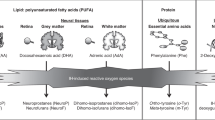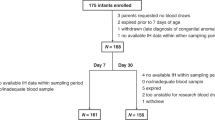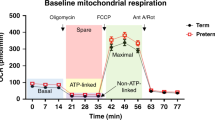Abstract
Previous studies have demonstrated increased oxidative damage to proteins and increased lipid peroxidation products in the plasma of hypoxic newborns at birth. We tested the hypothesis that hypoxic preterm newborns are at increased risk for oxidative stress in the first week of life. Heparinized blood samples of 34 hypoxic and 15 control preterm newborns were obtained at birth from the umbilical vein immediately after delivery and from a peripheral vein on postnatal d 7. Plasma levels of hypoxanthine, total hydroperoxide (TH), and advanced oxidation protein products (AOPP) were measured in cord blood and blood drawn on d 7. Hypoxanthine, TH, and AOPP levels were significantly higher in cord and d 7 blood samples of hypoxic newborn than control infants. Statistically significant correlations were observed between AOPP and hypoxanthine and between AOPP and TH plasma levels on d 7. AOPP and TH plasma levels significantly increased from cord to d 7 blood in neonates without hypoxia. These findings show that the oxidative stress observed in cord blood of hypoxic preterm newborns is still higher than control infants on d 7. The significant increase in TH and AOPP levels in nonhypoxic preterm newborns at the end of the first postnatal week indicates that damage caused by free radicals also occurs in nonhypoxic babies with normal clinical course. In summary, TH and AOPP production is prolonged for several days after birth in hypoxic preterm babies. The risk of free radical damage is lower but still exists in preterm neonates with normal clinical course.
Similar content being viewed by others
Log in or create a free account to read this content
Gain free access to this article, as well as selected content from this journal and more on nature.com
or
Abbreviations
- Hx:
-
hypoxanthine
- AOPP:
-
advanced oxidation protein products
- TH:
-
total hydroperoxide
- FR:
-
free radical
- CI:
-
confidence interval
References
Maulik D, Numagami Y, Ohnishi ST, Mishra OP, Delivoria-Papadopoulos M 1998 Direct detection of oxygen free radical generation during in utero hypoxia in the fetal guinea pig brain. Brain Res 798: 166–172
Mishra OP, Delivoria-Papadopoulos M 1989 Lipid peroxidation in developing fetal guinea pig brain during normoxia hypoxia. Dev Brain Res 45: 129–135
Hasegawa K, Yoshioka H, Sawada T, Nishikawa H 1991 Lipid peroxidation in neonatal mouse brain subjected to two different types of hypoxia. Brain Dev 13: 101–103
Halliwell B 1994 Free radicals, antioxidants human disease: curiosity, cause, or consequence?. Lancet 344: 721–724
Saugstad OD 1996 Mechanisms of tissue injury by oxygen radicals: implications for neonatal disease. Acta Paediatr 85: 1–4
Jacob RA 1995 The integrated antioxidant system. Nutr Res 15: 755–766
Frank L, Sosenko RS 1987 Development of lung anti-oxidant enzyme system in late gestation: possible implications for the prematurely born infant. J Paediatr 110: 9–14
Buonocore G, Perrone S, Longini M, Terzuoli L, Bracci R 2000 Total hydroperoxide advanced oxidation protein products in preterm hypoxic babies. Pediatr Res 47: 221–224
American College of Obstetricians and Gynecologists 1994 Fetal Distress and Birth Asphyxia. Washington, DC: American College of Obstetricians and Gynecologists. ACOG Committee Opinion 137
Buonocore G, Zani S, Perrone S, Caciotti B, Bracci B 1998 Intraerythrocyte nonprotein-bound iron plasma malondialdehyde in the hypoxic newborn. Free Radic Biol Med 25: 766–770
Buonocore G, Perrone S, Gioia D, Gatti MG, Massafra C, Agosta R, Bracci R 1999 Nucleated red blood cell count at birth as an index of perinatal brain damage. Am J Obstet Gynecol 181: 1500–1505
Witko-Sarsat V, Friedlander M, Capeillere-Blandin C, Nguyen-Khoa T, Thu Nguyen A, Zingraff J, Jungers P, Descamps-Latsca B 1996 Advanced oxidation protein products as a novel marker of oxidative stress in uremia. Kidney Int 49: 1304–1313
Buonocore G, Perrone S, Bracci R 2001 Free radicals brain damage in the newborn. Biol Neonate 79: 180–186
McCord JM 1985 Oxygen-derived free radicals in postischemic tissue injury. N Engl J Med 312: 159–163
Sutton HC, Winterbourn CC 1989 On the participation of higher oxidative states of iron copper in Fenton reactions. Free Radic Biol Med 6: 53–60
Kukreja RC, Kontos HA, Hess ML, Ellis EF 1986 PGH synthase lipoxygenase generate superoxide in the presence of NADH or NADPH. Circ Res 59: 612–619
Turrens JF 1997 Superoxide production by the mitochondrial respiratory chain. Biosci Rep 17: 3–8
Mishra OP, Delivoria-Papadopoulos M 1999 Cellular mechanisms of hypoxic injury in the developing brain. Brain Res Bull 48: 233–238
Bracci R, Buonocore G 1998 The antioxidant status of erythrocytes in preterm term infants. Semin Neonatol 3: 191–197
Gophinathan V, Miller NJ, Milner AD, Rice-Evans CA 1994 Bilirubin ascorbate: antioxidant activity in neonatal plasma. FEBS Lett 349: 197–200
Saugstad OD 2001 Update on oxygen radical disease in neonatology. Curr Opin Obstet Gynecol 13: 147–153
Saugstad OD 1988 Hypoxanthine as an indicator of hypoxia: its role in health disease through free radical production. Pediatr Res 23: 143–150
Saugstad OD 1996 Role of xanthine oxidase its inhibitor in hypoxia: reoxygenation injury. Pediatrics 98: 103–107
Turrens JG, Alexandre A, Lehninger AL 1985 Ubisemiquinone is the electron donor for superoxide formation by complex III of heart mitochondria. Arch Biochem Biophys 237: 271–278
Ying W, Han S-K, Miller JW, Swanson RA 1999 Acidosis potentiates oxidative neuronal death by multiple mechanisms. J Neurochem 73: 1549–1556
Buonocore G, Zani S, Sargentini I, Gioia D, Signorini C, Bracci R 1998 Hypoxia-induced free iron released in the red cells of newborn infants. Acta Paediatr 87: 77–81
Evans PJ, Evans R, Kovar IZ, Holton AF, Halliwell B 1992 Bleomycin-detectable iron in the plasma of premature full-term neonates. FEBS Lett 303: 210–212
Buonocore G, Gioia D, De Filippo M, Picciolini E, Bracci R 1994 Superoxide anion release by polymorphonuclear leukocytes in whole blood of newborns mothers during the peripartal period. Pediatr Res 36: 619–622
Saugstad OD, Rootwelt T, Aalen O 1998 Resuscitation of asphyxiated newborn infants with room air or oxygen: an international controlled trial: the Resair 2 study. Pediatrics 102: e1
Author information
Authors and Affiliations
Corresponding author
Additional information
Supported by the Italian Ministry for the University and Scientific-Technological Research (COFIN 99 Funds).
Rights and permissions
About this article
Cite this article
Buonocore, G., Perrone, S., Longini, M. et al. Oxidative Stress in Preterm Neonates at Birth and on the Seventh Day of Life. Pediatr Res 52, 46–49 (2002). https://doi.org/10.1203/00006450-200207000-00010
Received:
Accepted:
Issue date:
DOI: https://doi.org/10.1203/00006450-200207000-00010
This article is cited by
-
Lower plasma melatonin levels in non-hypoxic premature newborns associated with neonatal pain
European Journal of Pediatrics (2024)
-
Association between adherence to a low carbohydrate dietary (LCD) pattern with breast milk characteristics and oxidative markers in infants’ urine: a cross-sectional study
Journal of Health, Population and Nutrition (2023)
-
Association between thiol-disulfide hemostasis and transient tachypnea of the newborn in late-preterm and term infants
BMC Pediatrics (2023)
-
Evaluation of pro-oxidant antioxidant balance in retinopathy of prematurity
Eye (2022)
-
Elucidating the involvement of apoptosis in postmortem proteolysis in porcine muscles from two production cycles using metabolomics approach
Scientific Reports (2021)



